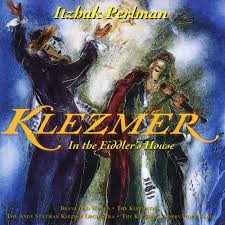 From the formal opening triumphant strains of “Brave Old World” to the highly-varied, improvisational closing “Di Gayster,” this recording explores the nooks and crannies of Klezmer music. The brain-child of Michael Alpert, violinist for the group Brave Old World, this recording explores four of the best-known contemporary Klezmer groups (the Klezmatics, the Andy Statmand Klezmer Orchestra, the Klezmer Conservatory Band, and Brave Old World) and, in the process, gives a brilliant overview of what Klezmer music is all about. The addition of Itzhak Perlman is the piece de resistance.
From the formal opening triumphant strains of “Brave Old World” to the highly-varied, improvisational closing “Di Gayster,” this recording explores the nooks and crannies of Klezmer music. The brain-child of Michael Alpert, violinist for the group Brave Old World, this recording explores four of the best-known contemporary Klezmer groups (the Klezmatics, the Andy Statmand Klezmer Orchestra, the Klezmer Conservatory Band, and Brave Old World) and, in the process, gives a brilliant overview of what Klezmer music is all about. The addition of Itzhak Perlman is the piece de resistance.
The best way to comprehend the scope and depth of the recording is to get to know the featured performers. Brave Old World was formed in 1989 in an effort to bring new Klezmer music to the world as a whole. This band has a style all their own, taking the roots of Yiddish music to new heights with a bit of jazz-like improvisation and a heart-felt sincerity. Their innovative material has included songs about contemporary issues (such as the fall of the Berlin Wall) and collaborative efforts with a wide variety of Eastern European musicians.
The Klezmatics work a great deal with traditional material, giving it a modern edge that appeals to a wide variety of audiences. Their vocals and clarinet lines (both alto and bass) give their music a wonderful layered texture.
The Andy Statman Klezmer Orchestra is the only representative without a vocalist, but their music stands alone beautifully. Statman’s legendary clarinet solos have an evocative Eastern flair seldom matched by others. Their music ranges in style, from the traditional to the modern, from Hasidic to rock ‘n’ roll. Excellent arranging makes this quartet sound much like chamber music in definition, without ever losing that truly Jewish feel.
The Klezmer Conservatory Band, like all of the above groups, includes the necessary violist, clarinetist, pianist, and accordion. But this group branches far beyond with a few extra instruments, including alto sax, vocals, flute, piccolo, cornet, trombone, mandolin, banjo, bass, and percussion. The result is Jewish gypsy music at its best, played with dizzying speed and accuracy.
What can be said of Itzhak Perlman that hasn’t already been said? Known as perhaps the foremost violinist in the world, Perlman’s ability to incorporate many styles has been highly regarded by many critics. He certainly doesn’t fall short on this recording, reaching back to the memories of his childhood in Israel to create just the right nuances and depth of feeling. It is clear that this music is very meaningful to him. His amazing expertise with the instrument just makes his feelings come out with more vividness than could possibly be accomplished by a lesser musician. It is Perlman’s virtuosity, along with Michael Alpert’s vision, that ties this album into a unified whole.
The music itself is varied and interesting. One of my favorite tracks is “Simkhes-Toyre Time,” which features the Klezmatics’ wonderful vocal stylings in an up-beat, invigorating party song. There are vocals solos traded off between the vocalists, giving wonderful texture to the piece. Even Itzhak Perlman takes a turn singing a verse. Another wonderful track is “Flatbush Waltz,” an Andy Statman original that features his outstanding mandolin playing. Alan Bern’s emotional piano playing makes this track a stand-out. This tune was recorded by the Irish group De Dannan.
The Klezmer Conservatory Band truly shines on “Firn Di Mekhutonim Aheym,” wringing every phrase for the most emotion. Another memorable track is the Klezmatic’s fascinating rendition of “Fisherlid/Klezmatics Khosidl,” which blends new and old for a fun and ironic look at a relatively contemporary ballad set to a traditional Hasidic tune. Other tunes include “Der Heyser Bulgar,” “Honga,” “Ale Brider,” and “Der Alter Bulgar & Forshpil.”
As if all of this isn’t enough, the album also boasts an excellent set of liner notes, including a brief history of each of the groups, a summary of the story of Klezmer music from the past to the present, and the lyrics to all the songs, presented in Hebrew text, phonetic spelling, and English translations. What better way to get fully acquainted with Klezmer music?
(Angel Records, 1995)
